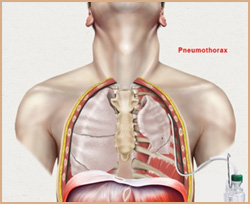

MBBS (AIIMS), MS (Surgery, AIIMS), MNAMS, FACS (USA), FICS (USA), FUICC
Mon, 29 Jan 2024

Pneumothorax, commonly called collapsed lung, is a serious medical condition when air gets trapped or accumulates inside the pleural space. The pleural space is the area between the lungs and the chest wall.
The condition can either be mild and treated by keeping the patient under observation or can become severe and require immediate medical attention.
In this comprehensive guide, we will explore everything there is to know about pneumothorax, its causes, diagnosis, and treatment. You can also consult Dr Arvind Kumar for more and detailed information.

Chest pain- Sudden, sharp chest pain on the same side as the affected lung.
Shortness of breath- This may be mild or severe, depending on how much of your lung is collapsed and whether you have underlying lung disease.
There are two main categories of pneumothorax medically distinguished, each with a list of causes.
This is further subdivided into two categories:
This kind of pneumothorax happens due to sudden chest trauma that can happen due to accidents, rib fractures, or severe penetrating injuries.
Understanding the causes of pneumothorax is quintessential to ensure that the patient gets timely and tailored treatment for quicker recovery.
The most common signs and symptoms of pneumothorax include:
Depending on the symptoms, one must assess whether or not the patient requires immediate medical attention. In most cases, it is better to consult a specialist like Dr Arvind Kumar immediately after the onset of the symptoms to ensure that things are under control.
The diagnosis of pneumothorax depends on two routes:
This involves the specialist conducting a physical examination to assess the extent of the lung collapse. The signs the doctor looks for during a physical examination include reduced chest movement on one side and a hyper-resonant percussion note.
To see the extent of the damage, the specialist will prescribe imaging tests like chest X-ray and CT scans to confirm the presence of pneumothorax and evaluate the extent of the damage that’s been caused. If the patient has a history of pneumothorax, a CT scan is ordered immediately.
Following the confirmed diagnosis, there are two modes of treatment depending on the severity of the collapse.
Irrespective of the route of treatment, pneumothorax is a severe condition that requires close monitoring and immediate medical interventions if things progress out of hand.
One should seek immediate medical help in case of sudden chest pain and troubled breathing. Many conditions other than pneumothorax can cause these symptoms, and most require an accurate diagnosis and prompt treatment. A patient with severe chest pain and progressive breathing difficulty should get immediate emergency care.
Pneumothorax is a potentially serious medical condition that requires prompt diagnosis and appropriate treatment. Early intervention and proper medical care from reliable and renowned specialists like Dr Arvind Kumar can lead to successful outcomes for individuals struggling with pneumothorax.
If you are experiencing pneumothorax symptoms and need professional advice and guidance, schedule an immediate consultation with Dr. Arvind Kumar for a timely diagnosis and appropriate treatment.
Copyright @ (Prof.) Dr. Arvind Kumar. All Rights Reserved / Thoracic Surgical Oncologis
License Number: U.P State Medical Council (India) No. 27637
